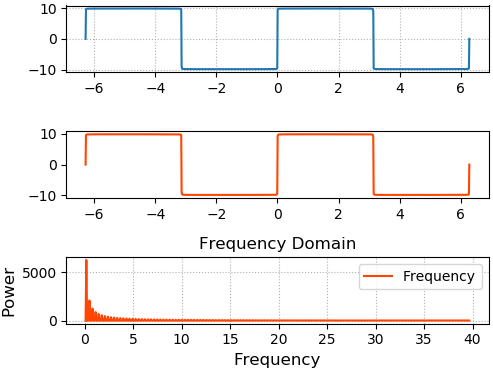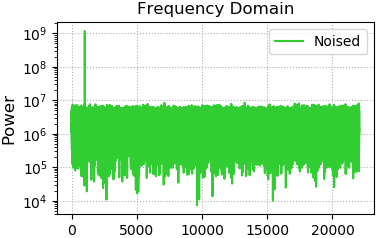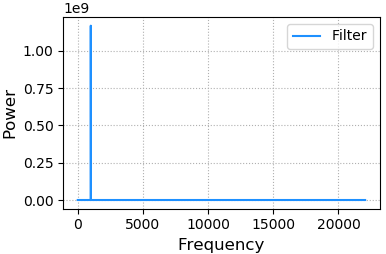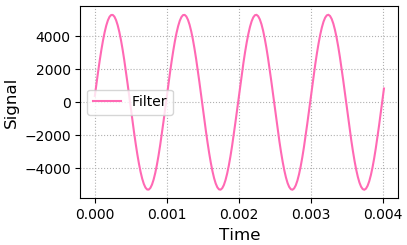Fourier transform (FFT)
French scientist Fourier suggested that any one cycle curve, no matter how irregular or jumping, can be expressed as the superposition of a set of sine curves and smooth. I.e., the Fourier transform is an irregular curve broken down into a set of smooth sine curve process.
Object is the Fourier transform to convert the time domain signal (i.e., a time domain) to the frequency domain (i.e., frequency domain) on the signal , with the transform domain, for the same understanding of the angle of the thing will change, Therefore, in place of some bad time domain processing, processing can be relatively simple in the frequency domain . This signal processing can significantly reduce the amount of storage.
For example: playing the piano
Suppose there is a time domain function: y = f (x), in accordance with Fourier theory it can be decomposed into a series of superimposed sine function, their amplitudes A, frequencies ω initial phase or different φ:
$$ y = A_1sin (\ omega_1x + \ phi_1) + A_2sin (\ omega_2x + \ phi_2) + A_2sin (\ omega_2x + \ phi_2) + R $$
Therefore, the Fourier transform may convert a relatively complex function of a simple superposition of a plurality of functions, also the angle of approach to the frequency domain from the time domain, some of them deal with the problem it will be relatively simple.
Fourier transform of the correlation function
freqs = np.fft.fft.fftfreq (number of samples, the sampling period) is obtained by Fourier transform of the resulting sample number exploded sampling period frequency series array
np.fft.fft .fft (original sequence) the sequence of the original function of the value after the fast Fourier transform to obtain a complex arraymode is represented by the complex amplitude of the early phase of the complex argument representatives
np.fft.fft .ifft (complex sequence) complex array obtained through the inverse Fourier transform of the synthesized array of function values
Case: the composite wave made for fast Fourier transform, to obtain an array of frequency decomposition wave amplitude, initial phase array, and draws an image in the frequency domain.
import numpy as np import matplotlib.pyplot as plt import numpy.fft as fft x = np.linspace(-2 * np.pi, 2 * np.pi, 1000) n = 1000 y = np.zeros(x.size) for i in range(1, n + 1): y += 4 * np.pi / (2 * i - 1) * np.sin((2 * i - 1) * x) complex_array = fft.fft(y) print(complex_array.shape) # (1000,) print(complex_array.dtype) # complex128 print(complex_array[0]) #(-2.1458390619955026e-12 is + 0j) y_new = fft.ifft (complex_array) plt.subplot ( 311 ) plt.grid (lineStyle = ' : ' ) plt.plot (X, Y, label = ' Y ' ) # Y is 1000 sinusoidal sequence summing plt.subplot (312 ) plt.plot (X, y_new, label = ' y_new ' , Color = ' OrangeRed ' ) # Y is ifft converted sequence # achieve frequency alignment decomposition wave freqs fft.fftfreq = (x.size, X [. 1] - X [0]) # complex mode amplitude (magnitude of energy) signal complex_array = fft.fft(y) pows = np.abs(complex_array) plt.subplot(313) plt.title('Frequency Domain', fontsize=16) plt.xlabel('Frequency', fontsize=12) plt.ylabel('Power', fontsize=12) plt.tick_params(labelsize=10) plt.grid(linestyle=':') plt.plot(freqs[freqs > 0], pows[freqs > 0], c='orangered', label='Frequency') Plt.legend () plt.tight_layout () plt.show ()

Fourier transform based frequency domain filter
Noisy low-energy signal is an energy signal and the noise superimposed signal, a frequency domain filtering may be achieved by a Fourier transform noise.
By the FFT noise-containing signal into a frequency spectrum containing noise, low energy noise is removed, leaving a high-energy spectrum after leaving the high-energy signal through IFFT.
Case: removing noise (frequency domain filtering as an audio file based on Fourier transform noiseed.wav data set address ).
1, reads the audio file, an audio file obtaining basic information: the number of sampling, the sampling period, the value of each sampled audio signal. Rendering the audio time domain: time / displacement image
Import numpy AS NP Import numpy.fft AS NF Import scipy.io.wavfile AS WF Import matplotlib.pyplot AS PLT # reading audio file sample_rate, noised_sigs = wf.read ( ' ./da_data/noised.wav ' ) Print (sample_rate ) # sample_rate: sampling rate 44100 Print (noised_sigs.shape) # noised_sigs: storing the audio samples for each sampling point displacement (220500,) Times = np.arange (noised_sigs.size) / sample_rate plt.figure ( ' the Filter ' ) plt.subplot ( 221 ) plt.title ( ' Time the Domain', fontsize=16) plt.ylabel('Signal', fontsize=12) plt.tick_params(labelsize=10) plt.grid(linestyle=':') plt.plot(times[:178], noised_sigs[:178], c='orangered', label='Noised') plt.legend()

2, based on Fourier transform, obtaining the audio frequency domain information, rendering the audio frequency domain: frequency / energy image
# Fourier transformed, frequency domain images drawn freqs = nf.fftfreq (times.size, Times [. 1] - Times [0]) complex_array = nf.fft (noised_sigs) POWs = np.abs (complex_array) plt.subplot ( 222 ) plt.title ( ' Frequency the Domain ' , fontSize = 16 ) plt.ylabel ( ' the Power ' , 12 is fontSize = ) plt.tick_params (labelsize = 10 ) plt.grid (lineStyle = ' : ' ) # exponential growth coordinates Paint plt.semilogy (freqs [freqs> 0], POWs [freqs> 0], C = ' LimeGreen', label='Noised') plt.legend()

3, the low-frequency noise removing the audio frequency domain drawing: frequency / energy image
# Seeking maximum frequency energy value fund_freq = freqs [pows.argmax ()] # the WHERE function to find those who need to erase the plural index noised_indices = np.where (freqs! = Fund_freq) # copy of a copy of a complex array, to avoid contamination raw data filter_complex_array = complex_array.copy () filter_complex_array [noised_indices] = 0 filter_pows = np.abs (filter_complex_array) plt.subplot ( 224 ) plt.xlabel ( ' Frequency ' , 12 is fontSize = ) plt.ylabel ( ' the Power ' , fontSize 12 is = ) plt.tick_params (labelsize = 10 ) plt.grid(linestyle=':') plt.plot(freqs[freqs >= 0], filter_pows[freqs >= 0], c='dodgerblue', label='Filter') plt.legend()

4, based on the inverse Fourier transform to generate a new audio signal, the audio rendering time domain: time / displacement image
filter_sigs = nf.ifft(filter_complex_array).real plt.subplot(223) plt.xlabel('Time', fontsize=12) plt.ylabel('Signal', fontsize=12) plt.tick_params(labelsize=10) plt.grid(linestyle=':') plt.plot(times[:178], filter_sigs[:178], c='hotpink', label='Filter') plt.legend()

5, regenerate the audio file
# Audio file is generated wf.write ( ' ./da_data/filter.wav ' , sample_rate, filter_sigs) plt.show ()